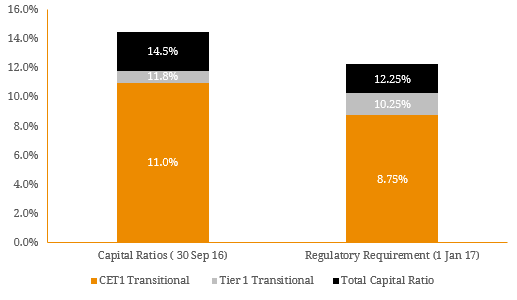In a stress test of Eurozone’s biggest lenders carried out by ECB last year, UniCredit emerged as the sixth weakest bank in the region. In an effort to distance itself from Italy’s prolonged banking crisis the Italian bank unveiled an “aggressive and immediate” approach to cut asset hangover and clean up its balance sheet in December 2016. After various disposals including the fire sale of €18 billion of securitized Italian bad loans, the company booked an additional €8.1 billion provision for bad debts in the 2016 4th quarter and these write-offs significantly affected the bank’s capital position. To salvage its credit profile, the bank has recently announced a €13bn rights issue – its third significant cash injection since 2008 and Italy’s biggest corporate cash call – aimed at plugging a €12.2bn gap primarily created by bad loan provisions. Just ahead of the Extraordinary General Meeting (EGM) to approve the rights issue, UniCredit warned that failure of this process could impact the payment of coupons of the bank’s additional tier-1 (AT1) instruments. If the rights issue process does not conclude in time (March 10, 2017), the bank’s capital ratios could temporarily fall below the minimum distributable amount (MDA) and the Pillar 1 and Pillar 2 capital requirements (as defined by EU Capital Requirements Directive). According to market commentators, UniCredit’s MDA cushion was €6.1bn as at September 2016, which the provisional charges will wipe out. This would bar the bank it from paying coupons on its AT1 instruments. The rights issue was subsequently approved by 99.8% shareholders in the EGM but there still lies some uncertainty due to execution (timing) risk. Figure 1. UniCredit 6.75% September 2021 AT1 Hybrid Historical Trading Margin  Figure 1. UniCredit Capital Ratios and requirements
Figure 1. UniCredit Capital Ratios and requirements  Source: Company Reports Under Eurozone banking regulation, the Capital Requirements Directive (CRD IV) Combined Buffer Requirement (CBR) (a supervisory framework in the European Union which reflects the Basel III rules on capital measurement and capital standards) was phased in from January 2016. Under this framework, a bank breaching the requirement must calculate a maximum distributable amount (MDA), determining how much it can pay out in AT1 coupons, dividends and employee compensation. Initially, the distressed financial institution had discretion to determine its priority of payments when it breaches the buffer. However, this was quickly adjusted to prioritise AT1 hybrid coupons amid concerns surrounding Deutsche Bank’s ability to pay coupons in 2016. Since this announcement, European AT1 hybrids have rebounded strongly (Figure 3). Further regulatory adjustments have supported the Additional Tier 1 (AT1) market going into 2017. This includes lower MDA thresholds in the ECB’s 2017 Supervisory Review and Evaluation Process (SREP) requirements which should reduce the risk of banks suspending coupon payments. Four European banks began the year with questions over their ability to pay coupons who booked significant provisions in late 2016 (UniCredit, Deutsche Bank, Banco Popular and Bremer Landesbank). For these banks, losses in the 2016 fourth quarter might either wipe out available distributable items or reduce their Common Equity Tier 1 (CET1) ratio below the MDA threshold. Figure 3. Markit IBoxx EUR Contingent Convertible Index
Source: Company Reports Under Eurozone banking regulation, the Capital Requirements Directive (CRD IV) Combined Buffer Requirement (CBR) (a supervisory framework in the European Union which reflects the Basel III rules on capital measurement and capital standards) was phased in from January 2016. Under this framework, a bank breaching the requirement must calculate a maximum distributable amount (MDA), determining how much it can pay out in AT1 coupons, dividends and employee compensation. Initially, the distressed financial institution had discretion to determine its priority of payments when it breaches the buffer. However, this was quickly adjusted to prioritise AT1 hybrid coupons amid concerns surrounding Deutsche Bank’s ability to pay coupons in 2016. Since this announcement, European AT1 hybrids have rebounded strongly (Figure 3). Further regulatory adjustments have supported the Additional Tier 1 (AT1) market going into 2017. This includes lower MDA thresholds in the ECB’s 2017 Supervisory Review and Evaluation Process (SREP) requirements which should reduce the risk of banks suspending coupon payments. Four European banks began the year with questions over their ability to pay coupons who booked significant provisions in late 2016 (UniCredit, Deutsche Bank, Banco Popular and Bremer Landesbank). For these banks, losses in the 2016 fourth quarter might either wipe out available distributable items or reduce their Common Equity Tier 1 (CET1) ratio below the MDA threshold. Figure 3. Markit IBoxx EUR Contingent Convertible Index  Source: Bloomberg While high-yield income products are on the uptake in 2017 given the low interest rate environment, the UniCredit announcement comes as a reminder of how coupon risk is an essential part of the construction of AT1 instruments. This reflects how investors are still susceptible to technical aspects of the asset class despite strict regulatory adherence.
Source: Bloomberg While high-yield income products are on the uptake in 2017 given the low interest rate environment, the UniCredit announcement comes as a reminder of how coupon risk is an essential part of the construction of AT1 instruments. This reflects how investors are still susceptible to technical aspects of the asset class despite strict regulatory adherence.

